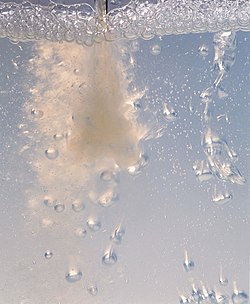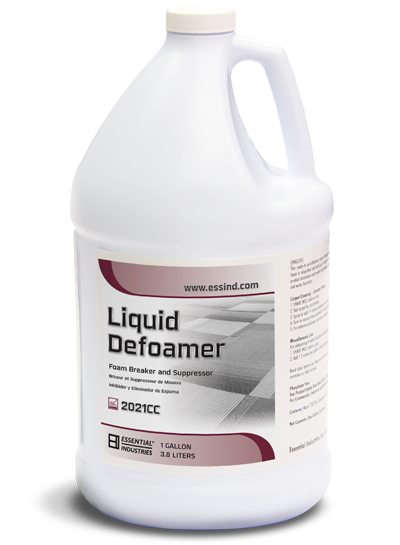Checking Out the Perks of a Chemical Defoamer in Production and Production
The combination of chemical defoamers in manufacturing and manufacturing procedures uses a calculated advantage by attending to one of the persistent challenges in commercial operations: foam control. As makers strive to enhance processes and enhance consumer contentment, the duty of chemical defoamers comes to be significantly crucial.
Significance of Foam Control
While the visibility of foam in making procedures can occasionally seem harmless, efficient foam control is important for optimizing operational effectiveness and item high quality. Foam can conflict with numerous phases of production, resulting in ineffectiveness that might extend and boost prices handling times. In sectors such as food and drink, drugs, and chemicals, uncontrolled foam can obstruct tools, interfere with automated systems, and inevitably result in product inconsistencies.

Carrying out effective foam control methods not just enhances efficiency yet also sustains governing compliance in industries where foam can cause ecological concerns. By utilizing chemical defoamers, makers can mitigate these challenges, ensuring smoother operations and higher-quality end products. Eventually, focusing on foam control is an important aspect of manufacturing that can produce significant benefits in regards to item, performance, and safety and security reliability.
Kinds of Chemical Defoamers
What kinds of chemical defoamers are readily available for manufacturing processes, and how do they differ in application? Chemical defoamers can be categorized right into 3 major kinds: silicone-based, natural, and inorganic defoamers. - Chemical Defoamer

Organic defoamers, generally stemmed from all-natural oils or fatty acids, work in a variety of applications, including food and beverage production. They are commonly preferred for their lower poisoning and ecological impact, making sure compliance with industry policies.

Each type of defoamer offers unique purposes based upon the chemical composition and the details demands of the manufacturing procedure, enabling manufacturers to select the most ideal choice for their particular requirements.

Benefits in Manufacturing Performance
Chemical defoamers play an essential function in enhancing producing efficiency by properly controlling foam generation during numerous processes. Foam can impede website link manufacturing rates, interfere with equipment operation, and bring about costly downtime. By integrating chemical defoamers, manufacturers can reduce these concerns, ensuring smoother workflow and boosted total productivity.
Making use of chemical defoamers aids maximize the operational performance of tools such as pumps, activators, and mixers. With reduced foam, these machines can run at their meant ability, minimizing the danger of overflow and making it possible for constant handling. This causes far better resource usage and greater throughput.
Additionally, chemical why not try here defoamers promote faster handling times by decreasing the moment needed for foam removal. This velocity can substantially influence manufacturing schedules, enabling suppliers to fulfill customer demand more effectively. Additionally, using defoamers adds to decrease power intake, as equipment runs a lot more efficiently with lowered foam interference.
Influence On Product High Quality
Foam control is not just necessary for maintaining efficiency in making procedures however likewise plays a considerable function in guaranteeing product quality. Excessive foam can present air right into solutions, causing variances in the final product. This can manifest as defects such as gaps, irregular structures, or below average surfaces, which undermine the intended high quality and performance of the product.
Furthermore, foam can prevent the homogeneity of blends, leading to uneven distribution of energetic ingredients. In sectors such as coatings, cosmetics, and food manufacturing, this can cause variations in shade, taste, and total efficiency. By utilizing a chemical defoamer, manufacturers can mitigate these threats, guaranteeing that items satisfy stringent top quality specs.
In addition, regulating foam can boost the stability of suspensions and emulsions, which is critical for making certain shelf-life and consumer satisfaction. With enhanced product uniformity and reduced flaws, manufacturers can accomplish higher requirements of high quality assurance, eventually bring about enhanced consumer count on and brand name commitment.
Cost-Effectiveness and ROI
Efficient foam control not only improves item quality but likewise adds considerably to the general cost-effectiveness of manufacturing processes. Making use of chemical defoamers lessens foam-related issues, which can otherwise lead to production hold-ups, equipment breakdowns, and increased energy consumption. By lowering foam, manufacturers can you could try here enhance their processes, resulting in higher throughput and effectiveness.
Buying chemical defoamers can produce a substantial roi (ROI) The initial expenses connected with these ingredients are often balanced out by the cost savings understood from lowered downtime and enhanced product return. Improved item high quality can minimize waste and revamp costs, even more strengthening economic performance.
In enhancement, reliable foam control can lead to reduced water and power usage, contributing to lower operational prices. This is specifically vital in sectors where source effectiveness is extremely important. By incorporating chemical defoamers right into their procedures, suppliers can accomplish long-lasting cost savings while keeping affordable prices in the marketplace.
Conclusion
In final thought, the assimilation of chemical defoamers in manufacturing and manufacturing procedures is crucial for maximizing functional efficiency and enhancing product top quality. Efficient foam control contributes to improved equipment efficiency, lowered handling times, and decreased downtime, eventually resulting in substantial cost financial savings. Furthermore, constant product formulations foster customer contentment and brand name commitment. The benefits used by chemical defoamers not only support governing compliance but additionally supply an one-upmanship in the production landscape.
The integration of chemical defoamers in production and manufacturing processes supplies a tactical advantage by resolving one of the persistent obstacles in industrial operations: foam control.While the visibility of foam in manufacturing processes can occasionally appear safe, efficient foam control is critical for enhancing functional performance and item quality.Chemical defoamers play a critical role in improving making efficiency by properly controlling foam generation during different processes.Additionally, chemical defoamers promote faster processing times by decreasing the time needed for foam elimination. Additionally, the usage of defoamers adds to decrease energy intake, as machinery operates extra efficiently with decreased foam disturbance.